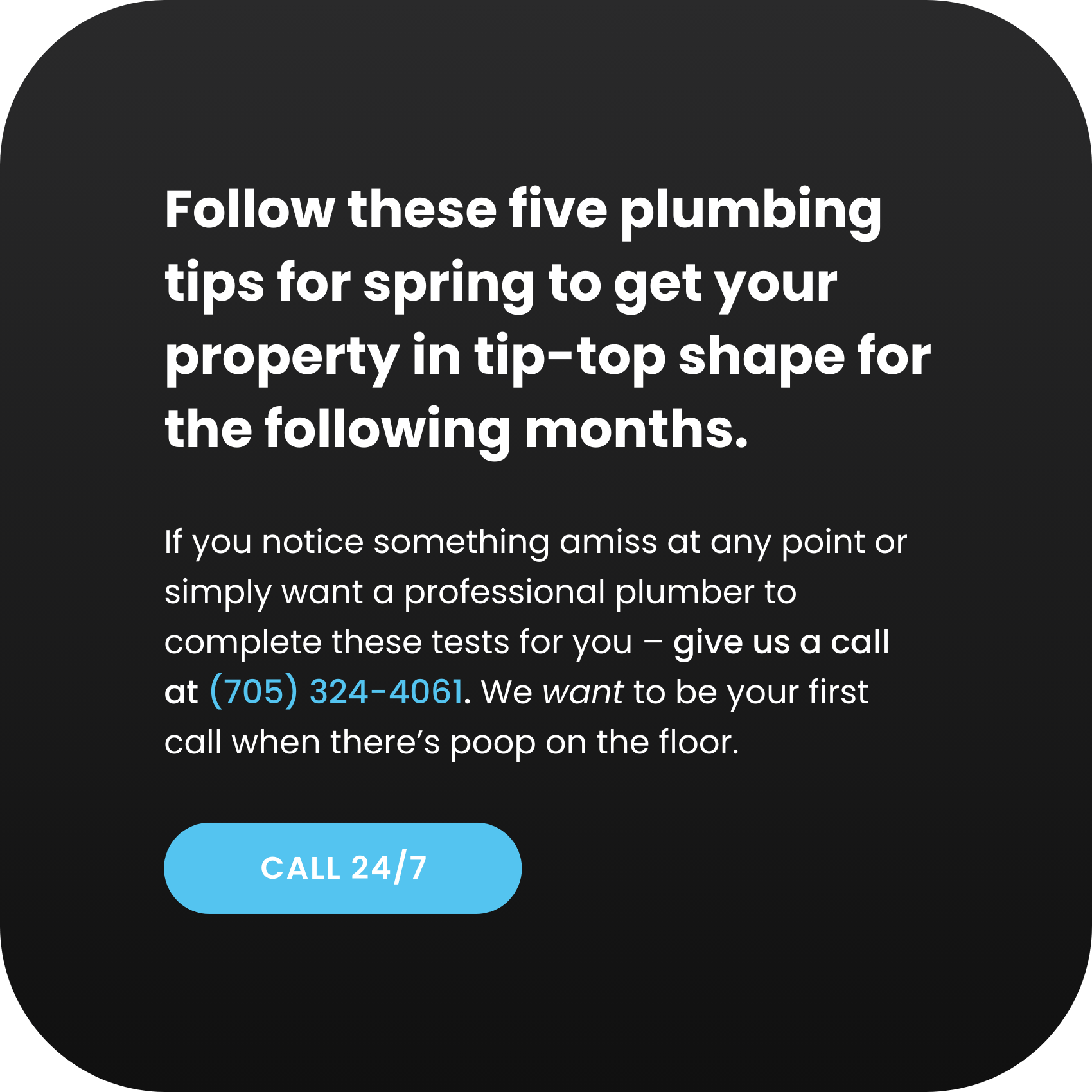5 Plumbing Tips for Spring
Spring is an incredibly joyful time of year. The snow starts to thaw, the sun starts to shine, and the days start getting longer and longer. It’s a season of new beginnings. If you’re anything like us, you perk up once March finally rolls around.
But spring isn’t all sunshine and rainbows; it’s also the time of year for household maintenance tasks – and that includes getting your plumbing in tip-top shape.
Without further ado, here are 5 plumbing tips for spring that should make it onto your to-do list.
1. Test the Plumbing Inside Your House
Make sure your TPR valve and sump pump are in great working condition by manually checking them for dysfunction.
Check to make sure your TPR valve is still operable by lifting it up and down. Make sure you have a bucket underneath, as some water will come out.
Run water through your sump pump and watch to make sure it reacts appropriately once a certain water level has been reached.
2. Address Leaks in Your House
If you’ve been putting off fixing leaks in your home because “it’s just a couple drops,” we have news for you: those drops add up substantially. On average, leaks will inflate your monthly water bill by 10%. Yearly, that can equate to $200 - $500!
Of course, leaks don’t always make themselves visibly apparent. You may have no idea if your home has one. And that’s where our tests come in:
Head on down to the water meter and check it, then avoid using any water in the house for the next two hours. Once that time is up, check your meter again. If it has changed then there’s a good chance you have a leak.
Put a drop of food colouring in your toilet tank. After approximately ten minutes, check the bowl for traces of the food colouring. If it has, you have a leak. Please remember to flush after the experiment so the food colouring does not stain the bowl!
Take a look at your water usage. As a rule of thumb, water usage should not exceed 12,000 gallons per month for a family of four during cooler months when sprinklers are not in use.
If your home plumbing system “fails” on any of these tests, it’s worth getting a professional in to resolve the issue. In the majority of cases, the money you save on your water bill will more than compensate for the cost of repair services.
3. Test Your Drains
While you can test your drains year-round, you’ll have a more accurate picture of their health during warmer months when any existing grease and/or oil in your pipes has thawed. Pour hot water down drains in your bathrooms / kitchen / laundry room areas and make note of how fast it clears. If you notice that a drain is slow to do its job, or hear gurgling as the water goes down, it’s time to get a professional plumber in.
4. Test Your Outdoor Plumbing Appliances
Your plumbing system doesn’t just exist inside the home. Spring is a great time to check out all outdoor components (including sprinklers and outdoor taps) to make sure they’re in good working condition. Inspect the exterior parts for breaks/splits/warps and test the functionality of each piece. If water fails to pass through, spits, or has an abnormal flow, you have an issue.
We also recommend that you clean your down-spouts during early spring. You can do this by shooting water down the top opening until all debris has been cleared. While you’re up there, you’ll also be able to notice if your gutters need some TLC – which they very well might.
5. Maintain Your Hot Water Heater
Over time, minerals found in water can collect in your hot water heater and solidify on the walls + floor of your unit. This burdens your hot water heater system, causes inefficiencies, and will shorten its lifespan considerably.
Keep your hot water heater in tip-top shape by flushing your system on an annual basis. To do so, you’ll need to:
Turn the thermostat on your water heater off, turn off the gas that flows to your hot water heater, and turn off the cold-water supply to your hot water heater.
Select a tap / faucet in your home and turn the hot water on – leave it on until the entire process has been completed.
Drain the water out of your water heater using a garden hose (the hose should lead outside, or to a bucket).
Turn on the cold-water supply to your hot water heater and let it pass through until there is no discoloration or sediment present. Once you’ve successfully flushed your unit, turn the drainage spigot off and disconnect the hose.
Turn off the tap / faucet that you turned on earlier, and turn on your cold-water supply.
Get air out of your plumbing system by going to a faucet and turning the hot water ‘on’ (since it was just flushed, there won’t actually be any hot water coming through). Turn the faucet off after a few seconds.
Turn on your gas supply and water heater thermostat.
In the event that you have an electric heater, you may need to restore power by switching the breaker on.
In twenty minutes, hot water will be restored!
While flushing your system is something you can do yourself, there’s room for errors to be made. If you’re unsure about what to do, we recommend talking to a professional.




